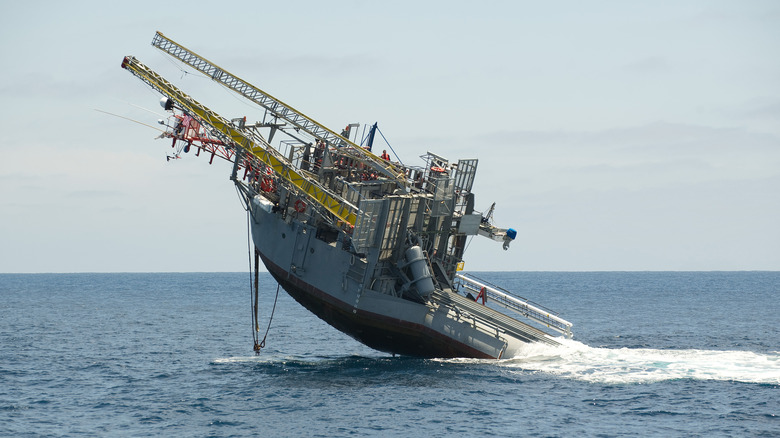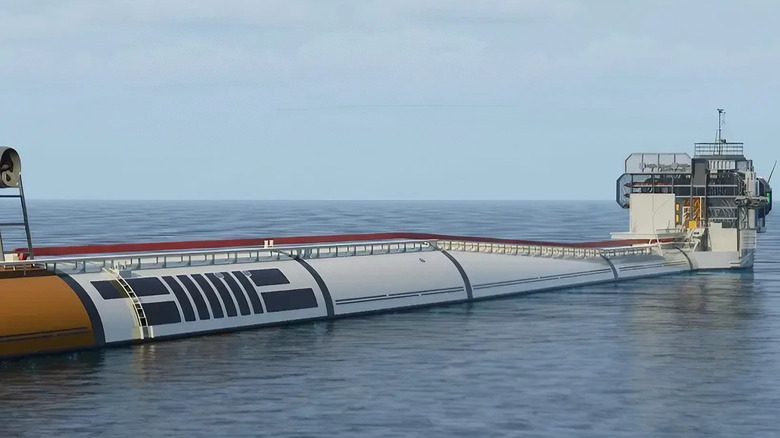Here's How This Strange Ship Can Flip From Horizontal To Vertical At Sea
Some of the wildest designs in engineering are born from a simple need. In the case of the Floating Instrument Platform, or FLIP, that need was for a research station that could sit dead still in the middle of a roiling ocean. The result is one of the most wonderfully bizarre vessels ever built. Measuring 108 meters long, the FLIP isn't really a ship at all. It's technically a massive spar buoy because it has no engine or propulsion of its own.
Its signature move is the flip, which is essentially a controlled sinking. This takes the FLIP from a horizontal, boat-like orientation to a vertical, standing one. How it works is deceptively simple. The process starts by flooding massive ballast tanks in the vessel's long, hollow tail. This leads to tons of water pouring in at a controlled rate, and air escapes with a whoosh. The entire transformation from horizontal to vertical takes about half an hour.
But the real magic happens in the last few minutes. The final rotation to 90 degrees occurs in a dramatic 90 seconds. During this process, its draft plummets from 12.6 feet to 300 feet. Life aboard is a trip. Inside, everything is built to work in two orientations. You'll find doors mounted on the floor and portholes in the ceiling. All these characteristics make it one of the weirdest, most specialized ships ever built.
But why need a ship that could stand?
Let's first understand why the ship flips at all. Why not just build a permanent floating tower? The answer is simple logistics. FLIP has no engines of its own, so it has to be towed like a barge to its research locations. Towing a 355-foot vertical structure across the ocean would be incredibly unstable and inefficient. The horizontal position is the only practical way to get it from port to its station. Once on site, it performs its signature trick.
As for why a floating tower is needed at all in the middle of the sea, there's quite a story behind it. Back in the '60s, the Navy was developing a frighteningly clever weapon called the UUM-44 SUBROC. This is one of the many missiles that can be launched from submarines, specifically a torpedo tube that could deliver a small nuclear warhead up to 34 miles away.
To make it work, they needed to study how sound travels underwater with extreme precision. The problem is that in the ocean, sound waves get distorted by layers of water with different temperatures and levels of salinity. Regular ships were simply too noisy and unstable for the delicate measurements required. Even advanced naval noise reduction systems couldn't have helped here.
The solution was a towed platform that could flip vertically, sinking most of its long hull deep below the turbulent surface waves to create a stable and silent listening post. After two years of work and a $600,000 investment, the FLIP was launched in 1962.
The FLIP almost died
After a legendary career spanning over 300 research missions, FLIP's time seemed to be up. Its final scientific cruise was in 2017. The Navy officially decommissioned it in August 2023 and it was towed to Mexico to be sold for scrap.
But then came a twist. News of its impending destruction reached the founder of DEEP, a subsea design firm. According to a report from the company, a team was scrambled and sent to Mexico within 48 hours to intercept the vessel. Giulio Maresca, FLIP's new captain, recalled the founder's unambiguous directive "Save her. Don't come back without her."
They succeeded. The rescued platform is now in France, undergoing a 12 to 18-month refit. DEEP plans to relaunch the modernized vessel in early 2026, equipped with state-of-the-art systems. It will play a key role in the company's mission to "make humans aquatic" by supporting the deployment of their Sentinel underwater habitats.


